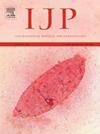Evidence for a constitutive cost of host resistance on body fat growth in ewe lambs from lines selected for resistance or susceptibility to experimental infections with Haemonchus contortus
IF 3.7
2区 医学
Q1 PARASITOLOGY
引用次数: 0
Abstract
Although benefits of selection for host resistance to gastro-intestinal nematodes have long been recognized, its costs on production traits remain unclear. A main difficulty when studying those costs is to disentangle genetic effects due to selection from plastic responses induced by infection. Putative costs of host resistance have been extensively investigated in growing sheep. However, while most of those studies have relied on live weight to assess body growth, more comprehensive assessments accounting for body composition are advocated to detect trade-offs. In this study we used 90 female lambs from lines divergently selected on resistance to Haemonchus contortus that we experimentally infected (n = 60) or not (n = 30) under controlled conditions. As those conditions were defined to enable uninfected lambs to fully express their growth potential, we sought to precisely identify the effects of selection for host resistance on health traits and on growth traits. We assessed muscular and fat growth based on repeated measurements with dorsal ultrasonography for all lambs on farm, and with whole-body computed tomography (CT) scans for a subgroup of 18 infected lambs. Lambs achieved a high growth rate, including infected ones despite their high worm burden (confirmed at necropsy in the subgroup). As expected, lambs from the resistant (R) line were less infected than those from the susceptible (S) line. However, the clear pathogenic effects observed on muscular growth and voluntary feed intake were similar between lines. In contrast, a line difference in body fat was supported both by dorsal and volumetric CT measurements. Specifically, lower fat in the R line compared with the S line was observed equally in infected and uninfected groups, thus providing evidence for a constitutive cost of host resistance. Although this cost is not necessarily disadvantageous in nutrient-rich environments exposing animals to excess fat deposition, its consequences in nutrient-scarce environments may be important to promote sustainable breeding strategies for host resistance.

有证据表明,宿主抗性对母羊羔羊体脂增长的构成性成本来自于对实验性传染性口蹄疫感染的抗性或易感性选育出的品系。
尽管宿主对胃肠道线虫的抗性选择所带来的益处早已得到认可,但其对生产性状所造成的代价仍不清楚。研究这些成本的一个主要困难是如何将选择的遗传效应与感染引起的可塑性反应区分开来。在绵羊生长过程中,对宿主抗性的成本进行了广泛研究。然而,虽然这些研究大多依赖活重来评估身体生长情况,但我们主张对身体组成进行更全面的评估,以检测权衡。在这项研究中,我们使用了 90 只雌性羔羊,这些羔羊来自对血包虫病具有抗性的不同选育品系,我们在受控条件下对它们进行了感染(n = 60)或不感染(n = 30)的实验。由于这些条件是为了让未感染的羔羊充分发挥其生长潜力,因此我们试图精确确定宿主抗性选择对健康性状和生长性状的影响。我们对农场所有羔羊的肌肉和脂肪生长情况进行了评估,这些评估是通过背侧超声波重复测量进行的,并对 18 只受感染羔羊进行了全身计算机断层扫描(CT)。羔羊的生长率很高,包括受感染的羔羊,尽管它们的虫体负担很重(在子组的尸体解剖中得到证实)。不出所料,抗性(R)品系羔羊的感染率低于易感(S)品系羔羊。然而,在肌肉生长和自愿采食量方面观察到的明显致病影响在不同品系之间是相似的。与此相反,体脂的品系差异得到了背侧和容积 CT 测量的支持。具体来说,与 S 系相比,R 系的脂肪较低,这一点在感染组和未感染组中都能观察到,从而为宿主抵抗力的构成代价提供了证据。虽然在营养丰富的环境中,这种代价不一定会使动物脂肪沉积过多,但在营养匮乏的环境中,其后果可能对促进可持续的抗宿主育种策略非常重要。
本文章由计算机程序翻译,如有差异,请以英文原文为准。
求助全文
约1分钟内获得全文
求助全文
来源期刊
CiteScore
8.40
自引率
2.50%
发文量
76
审稿时长
23 days
期刊介绍:
International Journal for Parasitology offers authors the option to sponsor nonsubscriber access to their articles on Elsevier electronic publishing platforms. For more information please view our Sponsored Articles page. The International Journal for Parasitology publishes the results of original research in all aspects of basic and applied parasitology, including all the fields covered by its Specialist Editors, and ranging from parasites and host-parasite relationships of intrinsic biological interest to those of social and economic importance in human and veterinary medicine and agriculture.

 求助内容:
求助内容: 应助结果提醒方式:
应助结果提醒方式:


